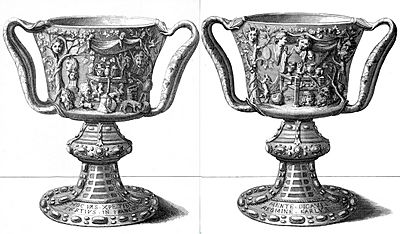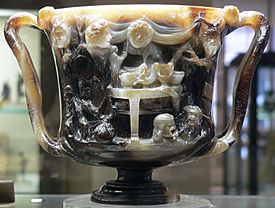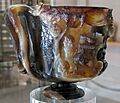Cup of the Ptolemies facts for kids
The Cup of the Ptolemies, also known as the Cup of Saint Denis, is a beautiful two-handled cup. It is made from a special stone called onyx and has detailed carvings. These carvings show scenes and symbols related to Dionysus, the ancient Greek god of wine, parties, and nature.
This amazing cup was probably made in Alexandria, Egypt, a very long time ago. It later became part of the treasures of the French kingdom. Then, it was given to the abbey of St. Denis. During the Middle Ages, people used it as a Christian chalice (a cup for religious ceremonies). Fancy gold decorations with Latin words were added to it.
In 1804, the cup was stolen. The gold decorations were lost, but the cup itself was found. Today, you can see the Cup of the Ptolemies in the Cabinet des Médailles at the Bibliothèque nationale de France in Paris.
Contents
What the Cup Looks Like
This special cup is a true masterpiece of hardstone carving from ancient times. It is carved from onyx and stands about 8.4 centimeters (3.3 inches) tall. Its widest part is about 12.5 centimeters (4.9 inches) across. The cup is covered with carvings that show scenes and symbols of Dionysus. These include masks, vases, holy animals, and garlands.
The Front of the Cup
What we now call the front of the cup shows six masks around a small table. This table looks like it's made of marble. Two sphinxes (mythical creatures) hold up the table. They represent the secret parts of the Dionysian religion.
On the table, there is a small statue of Hermes, a Greek god. Next to it hangs a mask with pipes. Above this mask, you might see the raven of Apollo, another Greek god. On the left side of the table, a goat is resting on the ground. It is surrounded by other symbols of the Dionysian religion. To the right of the table, there is a wicker basket. A snake comes out of this basket. This basket design is often seen in Dionysian art. It seems to have been very important to their religion.
The Back of the Cup
On the upper-left side of the cup's back, you can see the mask of Pan (a nature god) in a tree. Below it, a goat is reaching for ripe grapes. Behind the goat, there are fruits and another table. This is likely another small table with five ceremonial vessels on top.
On the left side of this table stands a small female figure. Her lit torches represent the fun parties and rituals of the Dionysian religion. Some experts believe this figure could be Telete or Ceres, two goddesses often linked with Dionysus. Above the table, there is a tapestry and two masks of bacchantes (followers of Dionysus). To the right, in an apple tree, you can see another mask of Pan. Two more bacchante masks are at the bottom, in front of the table.
It seems that people in the Middle Ages did not realize the cup's original pagan (non-Christian) meaning. They turned it into a Christian chalice. An expert named Erika Zwierlein-Diehl noted that many old descriptions of the cup did not mention its Dionysian carvings. They just said the cup had "trees, heads, animals, and birds." This forgetting of the original meaning helped old pagan items be used again for Christian purposes.
History of the Cup
The Cup of the Ptolemies was probably made in Alexandria, Egypt. For a long time, people thought it was made around 250 BC, during the Hellenistic period. However, experts now believe it was carved later, in the 1st century AD.
The idea that the cup was connected to the Ptolemies (a family of Egyptian rulers) started in 1644. A historian thought it was made for the funeral of Ptolemy II Philadelphus. He ruled Egypt from 285 to 246 BC. Later, another scholar suggested it was made generally during "the time of the Ptolemies." This period lasted from 305 to 30 BC. But there is no clear proof for this. Other experts think the cup was carved even later, in the 1st or 2nd centuries AD, by Romans. It's hard to know the exact date because there are very few similar cups to compare it to.
The exact journey of the cup through history is mostly unknown. One idea is that it belonged to the Holy Roman Emperor Charlemagne. Then, it might have been passed down through the French kings. One of these kings eventually gave it to the abbey of Saint Denis.
The cup was sometimes used as a chalice for communion wine in church services. It was also part of the coronation of the French monarch ceremonies. During these events, queens would use the cup after taking holy communion. In 1634, the cup was valued at about 25,000 livres. Its gold and gem-covered decorations were worth 1,200 livres. The cup stayed in the treasury of Saint-Denis until September 1791.
In 1804, the cup was stolen. When the thieves were caught in the Netherlands, the cup was found, but its beautiful gold decorations were gone. Today, the cup is kept safe in the Cabinet des Médailles in Paris.
The Chalice Mount

Sometime during the Carolingian period (around the 8th to 10th centuries), a base was added to the cup. This base made it look more like a traditional chalice. The cup's handle was also partly covered with gold work.
Later, in the 12th century, Abbot Suger of Saint Denis (who was in charge from 1122 to 1151 AD) probably made the chalice even more beautiful. He added metalwork that made its bottom wider. These decorations were made of gold and had many gems. After the cup was found in the 19th century, these gold decorations were missing. They were likely melted down for their valuable materials. Today, we only know what these decorations looked like from an engraving made by Michel Félibien in 1706.
Abbot Suger also added a two-line Latin inscription (words) to the chalice mount. We only know about these words from Félibien's engraving. The words meant: "The exalted Charles, third on the French throne, gave this vessel to you, Christ, with a faithful mind." Most experts agree that these words refer to Charles the Bald. He ruled Western Francia from 840 to 877 AD. Some others think it might refer to Charlemagne or Charles the Simple, but these ideas are less likely.
Images for kids
See also
 In Spanish: Copa de los Ptolomeos para niños
In Spanish: Copa de los Ptolomeos para niños






